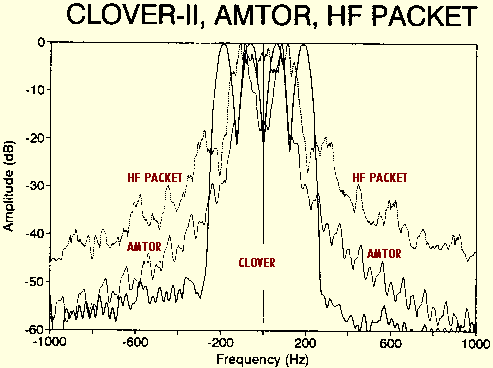
Every CLOVER data packet includes Reed-Solomon error correction data coding, the same type of coding used in audio compact disks. This allows CLOVER to correct many data errors without having to repeat a packet. In contrast, AMTOR, PACTOR, and AX.25 packet radio all must repeat data packets to correct for errors. If errors exceed the capacity of the Reed-Solomon encoder, CLOVER will also repeat packets, but only those packets that could not be corrected. We call this our ARQ selective repeat feature and it saves a lot of time. In the highest modulation mode - 16P4A (for 16 levels of phase and 4 levels of amplitude modulation) - 6 blocks of 255 bytes of data are sent in each transmission. If blocks 1, 2, 4, and 6 are received correctly but 3 and 5 have uncorrectable errors, data from blocks 1 and 2 are passed to the PC, blocks 4 and 6 are stored, and only blocks 3 and 5 are retransmitted. Unlike AMTOR, PACTOR, or AX.25, CLOVER does not retransmit data once it has been received correctly. The combination of Reed-Solomon error correction coding and selective ARQ repeat provides very efficient and fast error-free HF data transmission. CLOVER ARQ mode is also bi-directional - there is no OVER command. Unlike AMTOR and PACTOR, either station may transmit data at any time. You don't have to wait for the other station to finish or stick in weird "OVER" commands - just type. Forget OVER, MASTER, SLAVE, ISS, IRS, and all the other "ARQ Alphabet Soup". CLOVER is user-friendly and much like using a full-duplex telephone line modem - but on HF radio.
CLOVER transmissions are "transparent", sending all 8 data bits. Any of
your computer files and programs may be sent via CLOVER, error-free and
without modification. CLOVER ARQ mode includes code compression for rapid
file transfer, often reducing the size by 2:1 or by as much as 10:1,
further reducing the time it takes to send a data file.
Using extensive DSP signal processing, the CLOVER transmit waveform is
specifically designed to occupy the narrowest frequency spectra possible.
The CLOVER occupied bandwidth is 500 Hz, down to 50 dB below the peak
amplitude. This means that CLOVER signals may be spaced as close as 500 Hz
apart with no co- channel interference. In contrast, AMTOR signals must be
spaced 1 kHz apart, PACTOR 1.5 kHz apart, and HF packet signals 2 kHz apart
to prevent co-channel interference. CLOVER recognizes that present-day high
frequency bands are very crowded and that we must all transition to bandied
efficient modulation techniques to accommodate more users per kHz of HF
spectra.
